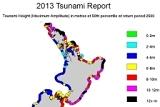 A new report published by GNS Science has increased the possible tsunami risk for Raglan from a wave height of 2 to 4 metres up to a wave height of 4 to 6 metres. The main risk around New Zealand is still seen as the North Island’s east-facing coasts. A tsunami information leaflet organised last year by the Raglan Community Board was stalled by officials. Recent organisational changes by Waikato District Council advised to the Raglan Community Board and budget provision in the annual plan, mean that Ngaruawahia may finally do something about making residents aware of the tsunami risk in Raglan and what they need to do if an alarm sounds.
A new report published by GNS Science has increased the possible tsunami risk for Raglan from a wave height of 2 to 4 metres up to a wave height of 4 to 6 metres. The main risk around New Zealand is still seen as the North Island’s east-facing coasts. A tsunami information leaflet organised last year by the Raglan Community Board was stalled by officials. Recent organisational changes by Waikato District Council advised to the Raglan Community Board and budget provision in the annual plan, mean that Ngaruawahia may finally do something about making residents aware of the tsunami risk in Raglan and what they need to do if an alarm sounds.
Recent tsunami research has presented New Zealand with a mixed bag of news. Parts of our coast are exposed to greater tsunami hazard than previously thought, while the hazard in other coastal regions is the same or less. The findings come from a new GNS Science report commissioned by the Ministry for Civil Defence and Emergency Management. It updates a report on New Zealand’s tsunami hazards that we compiled in 2005.
This year’s report incorporates new research and significant changes in scientific understanding since our 2005 report. It focuses on the entire New Zealand coastline rather than just the main population centres. It also uses more advanced modelling to quantify the tsunami hazard. Areas where the hazard is higher are the North Island’s east-facing coasts and the southwest of the South Island. In other coastal regions, the tsunami hazard remains about the same, or has even decreased.
The recent research and modelling has shown the hazard from near-source tsunami with little travel time is higher than previously estimated. This is particularly the case for tsunami generated by undersea earthquakes off the North Island’s east coast.
The 220-page report summarises the historical and geological record of tsunami in New Zealand. It notes that New Zealand has experienced about 10 tsunami of 5m or more since 1840. Focussing on the historical record of dangerous local and regional tsunami – those that take less than three hours to reach here – suggests that these nearby events may occur in New Zealand about every 40 to 50 years on average. So it is likely that at least one will occur in the lifetime of most New Zealanders.
The report is in some respects unique, because of the approach it takes and the level of sophistication in the modelling it uses. It focuses on tsunami hazard – the likely size and frequency of tsunami for given time periods. It does not provide estimates of damage, cost, and casualties. It concludes that over a 2500-year period, earthquake- generated tsunami are the major hazard, ahead of tsunami generated by seafloor landslides or volcanic activity.
Full report available here.

